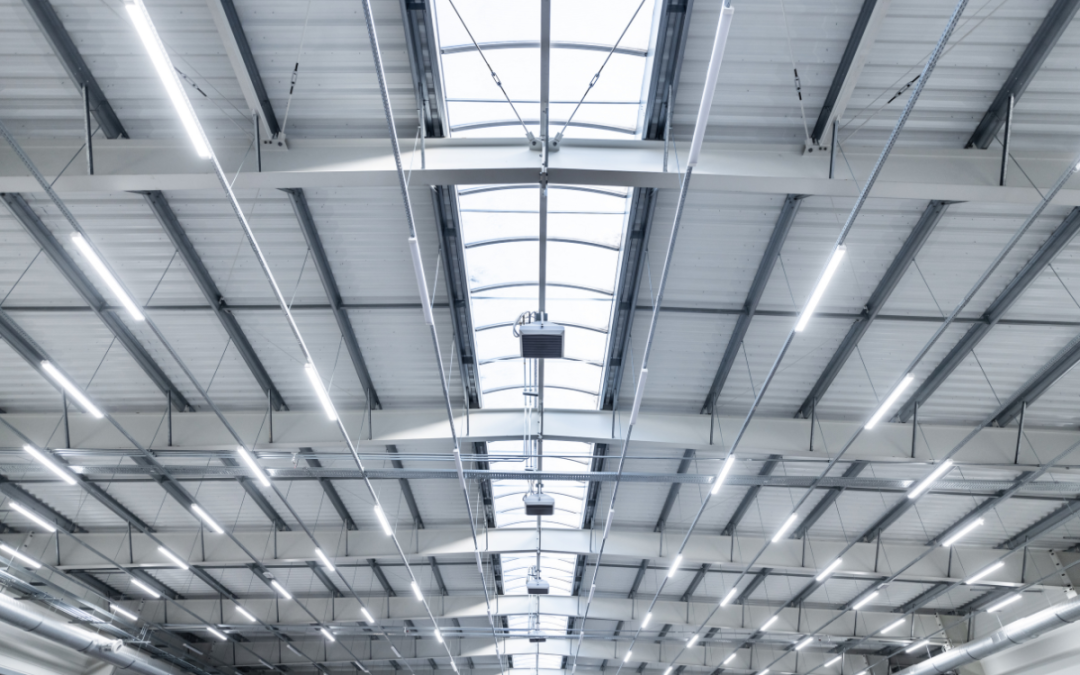The popularity of LED lighting has seen a significant upswing in recent years due to its remarkable energy efficiency, extended lifespan, and positive environmental attributes. While the initial cost of implementing LED lighting solutions may appear comparatively higher than traditional options, the advantages make it a smart investment for commercial and industrial spaces.
In the following sections, we will delve deeper into the key benefits of LED lighting, shedding light on how these advantages contribute to long-term sustainability. Additionally, we’ll discuss the importance of considering the overall lifecycle cost as a pivotal factor in making informed and economically sound purchasing decisions.
Energy Efficiency Lighting
LED lighting is energy efficient, which makes it a popular choice in various settings, including warehouses, offices, retail spaces, educational institutions and more.
In stark contrast to traditional incandescent bulbs or fluorescent lights, LEDs can convert a much higher percentage of electrical energy into visible light. This inherent efficiency translates into substantial energy savings, with a typical LED bulb consuming a mere 25% of the energy required by incandescent bulbs.
What are the implications for businesses?
Businesses that embrace LED lighting experience immediate financial benefits through reduced maintenance costs and lower electricity bills. However, they also play a pivotal role in fostering environmental sustainability. The 75% decrease in energy consumption inherent to LED technology reduces expenses and aligns with the broader goal of reducing carbon footprints. By switching to LEDs, businesses can make significant strides in achieving fiscal prudence and environmental responsibility objectives.
Increased Longevity and Durability
LEDs boast an impressive lifespan of up to 20 years, far exceeding the durability of traditional lighting solutions. The advanced technology used in LED production ensures reliable performance over an extended period, reducing the frequency of bulb replacements. Additionally, LED lights are highly durable and resistant to shocks, vibrations, and temperature fluctuations. The absence of fragile components like filaments or glass minimises the risk of damage during handling or transportation. This durability contributes to a longer lifespan and lower maintenance requirements, making LED lighting a practical and cost-effective solution for commercial and industrial spaces.
Environmentally Friendly Lighting Solutions
Sustainable LED lighting is crucial in fostering a greener and more environmentally friendly future. The extended lifespan of LED bulbs reduces the amount of waste generated, contributing to waste reduction efforts. Unlike fluorescent bulbs containing hazardous substances like mercury, LED lights are free from such harmful components, making them safer for users and the environment. Furthermore, the reduced energy consumption of LED lighting directly mitigates carbon emissions, aligning with global efforts to combat climate change and promote energy conservation.
Additional Benefits
Beyond the commonly known advantages of energy efficiency, longevity, and environmental friendliness, LED lighting offers many benefits that may not be widely acknowledged:
- Instant Light and Flicker-Free Operation: Unlike traditional lighting sources, LED lights provide instant illumination without needing to warm up. Additionally, they operate without flickering, which can reduce eye strain and create a more comfortable lighting environment for employees and customers who visit your premises.
- Directional Lighting: LEDs emit light in a specific direction, making them inherently more efficient for applications such as recessed lighting and task lighting. This directional characteristic reduces the need for reflectors and diffusers, which can be necessary with other lighting technologies.
- Instant Adaptability to Motion Sensors: LED lights can be easily integrated with microwave motion sensors for fine management of automatic activation or deactivation based on occupancy. This feature is beneficial in areas with varying usage patterns, such as hallways, parking lots, and warehouses.
- Low UV Emissions: LEDs emit very little ultraviolet (UV) light, reducing potential harm to sensitive objects or materials that may be adversely affected by UV radiation. This makes LED lighting suitable for illuminating artworks, artifacts, and items sensitive to UV exposure.
Looking Beyond the Initial Price Tag
While the upfront expense of LED lighting may appear higher, a comprehensive assessment of the overall lifecycle cost provides a more accurate financial perspective.
A historical perspective
Traditional bulbs and tubes are affordable and easily replaced, but their shorter lifespan leads to frequent changes, sometimes resulting in business downtime. By contrast, LED lights may necessitate replacing the entire fixture, appearing to increase costs. However, this perception can be misleading. LEDs’ extended lifespan and durability, along with lower maintenance needs, result in significant long-term savings.
Furthermore, the reduced maintenance requirements of LED lighting systems play a crucial role in enhancing overall cost-effectiveness. Traditional lighting sources often demand regular check-ups, replacements, and repairs, incurring additional costs and consuming valuable time. Meanwhile, LEDs require minimal maintenance, resulting in lower operational costs and improved efficiency.
Making the Switch to LED
In the pursuit of lighting that is sustainable and budget-friendly, LED technology emerges as a standout performer. Its efficiency, long lifespan, and eco-friendly nature make it an excellent choice for businesses seeking a lighting solution that will stand the test of time.
Ready to make the transition? Schedule a free lighting survey for commercial and industrial spaces with LED Lights 4 You.
What does the process entail?
In our thorough evaluation, we examine your current lighting fixtures, taking note of their load. Additionally, we measure LUX levels in key areas, accounting for natural light conditions. This valuable data is then integrated into our user-friendly lighting survey and comparison platform, generating an in-depth, easy-to-understand multi-page report.



